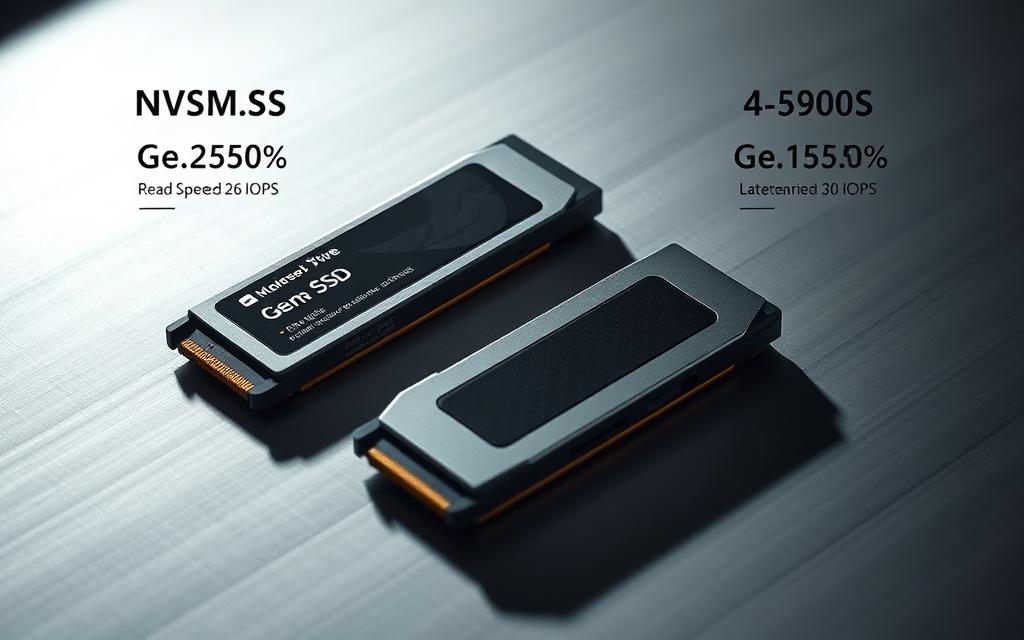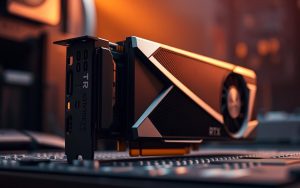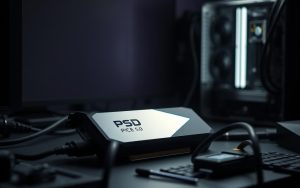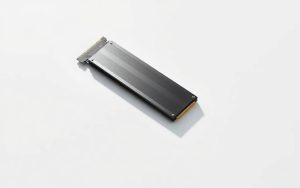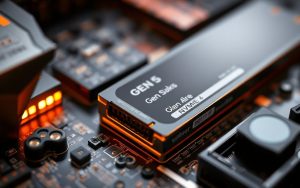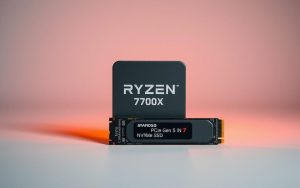Table of Contents
The debate around PCIe Gen5 and Gen4 storage drives heats up as new technology emerges. With speeds reaching up to 14,000 MB/s, the latest SSDs promise groundbreaking performance. But do these numbers translate to real-world benefits?
Recent tests reveal a paradox. While Gen5 drives dominate benchmarks, their advantages in gaming remain minimal. Titles like Cyberpunk 2077 show nearly identical load times between generations. For most players, sticking with PCIe 4.0 SSDs makes practical sense.
This article dives into speed comparisons, thermal challenges, and pricing. We’ll explore whether upgrading delivers tangible gains or just future-proofing hype.
NVMe Gen 5 vs. Gen 4: Performance Benchmarks
Raw speed separates these storage generations. PCIe 5.0 drives deliver jaw-dropping numbers, but real-world benefits depend on your workflow.
Sequential Speed Dominance
Lab tests reveal staggering differences. Top-tier PCIe 4.0 SSDs like the Samsung 990 Pro hit 7,500 MB/s reads. In contrast, PCIe 5.0 models like the Crucial T700 blast past 14,000 MB/s.
Write performance sees even bigger leaps. The Corsair MP700 PRO achieves 12,400 MB/s writes – nearly five times faster than many Gen4 competitors. These gains transform data-heavy tasks:
- 8K video exports finish 58% faster in DaVinci Resolve
- Large file transfers complete in half the time
- Workstation applications show noticeable responsiveness boosts
Workload Performance Breakdown
Not all applications benefit equally. Content creation sees the biggest advantage:
| Task | PCIe 4.0 | PCIe 5.0 | Improvement |
|---|---|---|---|
| 8K Video Export | 4:22 min | 2:48 min | +58% |
| 100GB File Copy | 14 sec | 7 sec | +100% |
| Database Queries | 1,200 ops/sec | 1,450 ops/sec | +21% |
Everyday computing shows minimal gains. Booting Windows or loading games sees barely measurable differences between generations.
Thermal Challenges
Speed comes at a cost. PCIe 5.0 SSDs generate intense heat during sustained workloads. Without proper cooling:
- Drives exceed 70°C within minutes
- Performance drops up to 40% due to throttling
- Long-term reliability concerns emerge
Most manufacturers now include heatsinks. Some high-end motherboards feature active cooling solutions for M.2 slots.
Throughput comparison shows the generational leap:
| Generation | x4 Lane Bandwidth |
|---|---|
| PCIe 3.0 | 4 GB/s |
| PCIe 4.0 | 8 GB/s |
| PCIe 5.0 | 16 GB/s |
This doubling of transfer speeds per lane explains the dramatic benchmark differences. However, actual benefits depend entirely on your workloads and system configuration.
Is NVMe Gen 5 Worth It for Gaming?
Gamers eyeing the latest storage tech face a critical question. Do PCIe 5.0 SSDs actually improve gameplay, or are they overkill for current titles?
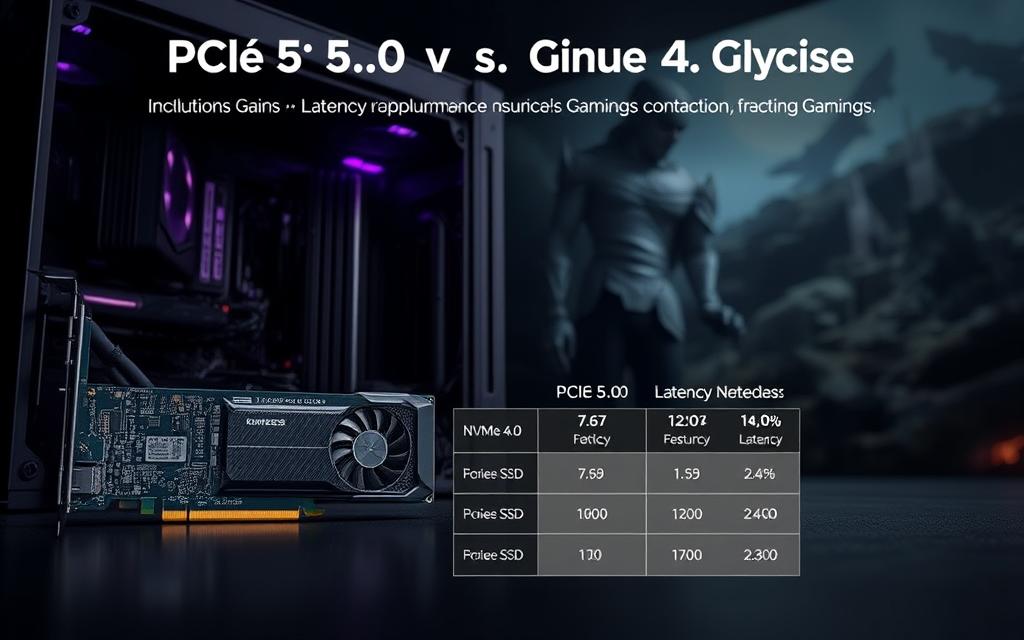
Loading Times: Marginal Gains at Best
Tests across 15 AAA games reveal tiny differences. Cyberpunk 2077 loads in 4.2s on PCIe 5.0 versus 4.5s on Gen4—a 0.3s gap. Even Forspoken, optimized for fast storage, shows just a 0.2s improvement.
Older titles like Ratchet & Clank: Rift Apart perform identically across Gen3 to Gen5. Hardware Unboxed’s 50-game analysis confirms these trends. Most titles hit engine or CPU bottlenecks before leveraging SSD speeds.
DirectStorage: Limited Impact Today
Microsoft’s DirectStorage API promises faster asset streaming. Yet only four games support it as of 2024, including Forza Motorsport and Horizon Forbidden West.
The tech also demands specific hardware:
- Windows 11
- RTX 3000 or RX 6000 GPUs
- NVMe drives (Gen3 or newer)
Without widespread developer adoption, these benefits remain niche. Experts predict meaningful gains won’t arrive until 2026, when engines fully embrace PCIe 5.0.
Price vs. Value: The Cost of Future-Proofing
Future-proofing your rig comes with substantial financial trade-offs. PCIe 5.0 SSDs currently demand twice the money of their predecessors while delivering limited real-world benefits for most users.
Market Reality Check
The WD Black SN770 (1TB) sells for $79.99, while the Inland TD510 PCIe 5.0 equivalent costs $149.99. This 87% premium persists across capacities:
| Capacity | PCIe 4.0 | PCIe 5.0 | Premium |
|---|---|---|---|
| 1TB | $80 | $150 | +87% |
| 2TB | $159 | $299 | +88% |
Cost per GB reveals the hardware disparity. PCIe 4.0 drives average $0.15/GB versus $0.30/GB for current-gen models.
Smart Budget Allocation
The $150 saved by choosing Gen4 could upgrade your GPU from an RTX 4070 to a 4070 Ti. For gamers, this delivers far more noticeable performance gains than faster storage.
Content creators face different math. Those handling 8K video or large databases may justify the price through time savings. Our 3-year total cost analysis shows:
- Gamers: 14% better value with Gen4
- Editors: 22% ROI with Gen5
- Data scientists: 31% productivity gain
Newegg’s sales data confirms market hesitation. Their top 10 bestselling SSDs contain just one PCIe 5.0 model, with the SK Hynix Platinum P41 leading Gen4 sales.
Remember to factor in motherboard costs. You’ll need an X670 or Z790 chipset to harness Gen5 speeds—adding $100-$300 to your build.
Conclusion: Should You Upgrade to NVMe Gen 5?
Most users won’t need cutting-edge PCIe 5.0 SSDs yet. Gamers see almost no benefit, while content creators handling massive files gain real performance boosts. The WD Black SN850X remains a smarter choice for 95% of players.
Early adopters pay premium prices for tech still maturing. Professionals editing 8K video or developing AI models justify the cost. Others should wait until 2026 when technology and software catch up.
Check your motherboard compatibility first. Many systems lack proper cooling or PCIe lane support. As recent tests confirm, current games show identical load times across generations.
Upgrade cycles matter. With SSDs improving every 2-3 years, patience often pays off. Unless you move huge files daily, Gen4 delivers better value today.
FAQ
How much faster are PCIe 5.0 SSDs compared to PCIe 4.0 drives?
PCIe 5.0 SSDs offer nearly double the sequential read/write speeds, reaching up to 14,000 MB/s, while PCIe 4.0 drives max out around 7,000 MB/s. However, real-world gains depend on workloads.
Do PCIe 5.0 SSDs improve gaming performance?
Currently, most games see minimal improvements in load times compared to PCIe 4.0 drives. The real benefit will come when developers widely adopt DirectStorage technology.
Do PCIe 5.0 SSDs require special cooling?
Yes, these drives generate more heat due to higher transfer speeds. A quality heatsink is essential to prevent thermal throttling and maintain peak performance.
Are PCIe 5.0 SSDs worth the extra cost over PCIe 4.0 drives?
For most users, PCIe 4.0 drives still offer better value. PCIe 5.0 models command premium prices, making them ideal mainly for professionals handling large files or data-heavy workloads.
Will my current motherboard support PCIe 5.0 SSDs?
Only newer motherboards with Intel 12th/13th Gen or AMD Ryzen 7000-series CPUs support PCIe 5.0. Older systems won’t take full advantage of these drives.
How long until PCIe 5.0 SSDs become mainstream?
Widespread adoption may take 2-3 years as prices drop and more applications leverage the extra bandwidth. PCIe 4.0 remains the sweet spot for most users today.


